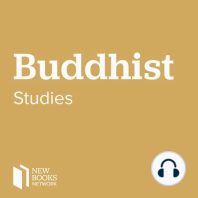73 min listen

Anna Andreeva, “Assembling Shinto: Buddhist Approaches to Kami Worship in Medieval Japan” (Harvard Asia Center, 2017)
Anna Andreeva, “Assembling Shinto: Buddhist Approaches to Kami Worship in Medieval Japan” (Harvard Asia Center, 2017)
ratings:
Length:
41 minutes
Released:
Feb 7, 2018
Format:
Podcast episode
Description
In her recent monograph, Assembling Shinto: Buddhist Approaches to Kami Worship in Medieval Japan (Harvard University Asia Center, 2017), Anna Andreeva focuses on a complex network of religious sites, figures, and texts to help us better understand the way in which Japanese deities were worshipped in medieval Japan. In so doing, she illuminates the medieval stages of a process that led to what was later called Shinto, and adds to the growing body of scholarship that challenges the relatively recent idea that Shinto is simply the native religion of Japan, unchanged since ancient times.
To tackle such a grand undertaking, Andreeva focuses on a mountain in central Japan called Mt. Miwa as well as on Ise, the location of the Ise shrines and the abode of the most important imperial deity. Beginning with the significance of Mt. Miwa as a religious site for pre-ninth-century Japanese rulers, Andreeva charts the decline of this mountain’s importance during the eighth-to-twelfth centuries and the subsequent revival of the site during the thirteenth century by non-elite practitioners of esoteric Buddhism stationed at small Miwa temples and by the Saidaiji lineage under the direction of the Buddhist monk Eison and his disciples. Continuing chronologically, she then shows how the thirteenth-century revival led some time later to the emergence of the so-called Miwa-ryu Shinto, an eclectic tradition which spread to different regions of Japan and whose influence continued until the early nineteenth century.
Central to Andreeva’s project is the world of Japanese esoteric Buddhist thought and ritual, for it was in this setting that the Japanese deities could be transformed from beings characterized by ignorance and desire into embodiments of Buddhist awakening. Throughout the book Andreeva addresses many religious elements, Japanese and not, that were incorporated into esoteric Buddhist traditions active at Mt. Miwa and Ise. These include the incorporation of deities from ancient Japanese mythology into medieval legends and esoteric ritual, serpentine and dragon imagery, initiation rites modeled on the enthronement of a king, pilgrimage, and the use of royal symbolism. In addition, she provides a number of detailed descriptions of rituals and translations of liturgical and exegetical works.
The book’s topic is very complex: Andreeva has opted out of the usual approach, which would be to trace the development of a single figure, text, idea, or institution. This makes the project far more difficult for the researcher, but has the invaluable advantage that it allows the reader to perceive and appreciate the fascinating networks that show how medieval Japanese religion actually existed and developed on the ground. Beyond its importance for understanding Japanese Buddhist intellectual history, esoteric Buddhist thought and ritual, and the development of Shinto, the book also serves as an example of how to study the intricate social, economic, and geographical networks that lie behind the development of religious ideas, practices, and institutions.Learn more about your ad choices. Visit megaphone.fm/adchoices
To tackle such a grand undertaking, Andreeva focuses on a mountain in central Japan called Mt. Miwa as well as on Ise, the location of the Ise shrines and the abode of the most important imperial deity. Beginning with the significance of Mt. Miwa as a religious site for pre-ninth-century Japanese rulers, Andreeva charts the decline of this mountain’s importance during the eighth-to-twelfth centuries and the subsequent revival of the site during the thirteenth century by non-elite practitioners of esoteric Buddhism stationed at small Miwa temples and by the Saidaiji lineage under the direction of the Buddhist monk Eison and his disciples. Continuing chronologically, she then shows how the thirteenth-century revival led some time later to the emergence of the so-called Miwa-ryu Shinto, an eclectic tradition which spread to different regions of Japan and whose influence continued until the early nineteenth century.
Central to Andreeva’s project is the world of Japanese esoteric Buddhist thought and ritual, for it was in this setting that the Japanese deities could be transformed from beings characterized by ignorance and desire into embodiments of Buddhist awakening. Throughout the book Andreeva addresses many religious elements, Japanese and not, that were incorporated into esoteric Buddhist traditions active at Mt. Miwa and Ise. These include the incorporation of deities from ancient Japanese mythology into medieval legends and esoteric ritual, serpentine and dragon imagery, initiation rites modeled on the enthronement of a king, pilgrimage, and the use of royal symbolism. In addition, she provides a number of detailed descriptions of rituals and translations of liturgical and exegetical works.
The book’s topic is very complex: Andreeva has opted out of the usual approach, which would be to trace the development of a single figure, text, idea, or institution. This makes the project far more difficult for the researcher, but has the invaluable advantage that it allows the reader to perceive and appreciate the fascinating networks that show how medieval Japanese religion actually existed and developed on the ground. Beyond its importance for understanding Japanese Buddhist intellectual history, esoteric Buddhist thought and ritual, and the development of Shinto, the book also serves as an example of how to study the intricate social, economic, and geographical networks that lie behind the development of religious ideas, practices, and institutions.Learn more about your ad choices. Visit megaphone.fm/adchoices
Released:
Feb 7, 2018
Format:
Podcast episode
Titles in the series (100)
Charlotte Eubanks, “Miracles of Book and Body: Buddhist Textual Culture and Medieval Japan (U of California Press, 2011): In Miracles of Book and Body: Buddhist Textual Culture and Medieval Japan (University of California Press, 2011), Charlotte Eubanks examines the relationship between MahÄyÄna Buddhist sÅ«tras and the human body, by New Books in Buddhist Studies